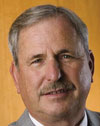 Program has blend of participants.
|
Project managers are core to the engineering and construction workforce, but they face new pressures as jobs grow more complex, workloads boom and veteran managers retire. In what could be a unique partnership, Parsons Corp., Pasadena, Calif., and Texas A&M University, College Station, are using the collective strengths of their employees and students, linked through virtual technology, to forge a master’s level project management degree program that also includes broader, nonengineering skills.
The program will graduate its first class next May and is the result of a linkage between Parsons and A&M’s departments of civil engineering and industrial/systems engineering, both units of its Dwight Look College of Engineering. “There are very few project management programs out there, and many are not in engineering,” says the program’s catalyst, John A. Scott, Parsons’ president and chief operating officer, who also is an Aggie graduate-level industrial engineer.
Virtual ClassmatesNow in its third year, the program will provide graduates with a Master’s of Science degree in engineering systems management and project management. Participants include both on-campus students and Parsons employees from around the U.S. and in Oman and Abu Dhabi who tap into recorded class lectures and interact with each other using virtual technology.
The program is self-paced for participants, with on-line quiz verification and documentation. About 37 employees are enrolled this semester. The approach is more convenient and less expensive for full-time workers with other personal commitments, says Scott. But he emphasizes that employee-students don’t just interact with their desk computers, as in other distance learning programs. “Most of the Parsons participants have a counterpart in class with whom to share notes,” says Scott.
 |
| SCOTT |
Their employer covers all costs for tuition and books, as well as for an annual week-long campus visit to “discuss what works and what doesn’t,” says Scott, who accompanies the visitors. The firm also covers costs for making courses compatible for distance learning and will subsidize an employee who needs to participate on campus for a team project. In addition, employees who accumulate a certain number of credit-hours may be eligible for a company-paid campus sabbatical, he adds.
The program includes traditional technical courses such as in engineering management and statistical analysis, but this year began featuring business, finance and government courses from other A&M colleges. Scott hopes to also integrate courses from the university’s psychology department to help PMs develop better people-management skills on-site and with clients. “We’re still not as diversified as we’d like to be,” he says. “The PM job is changing.”
Brett A. Peters, A&M industrial engineering department head, says the interaction between on-campus students and virtual peers is mutually beneficial. Students gain from the practical experience of typically older Parsons participants, while full-time students help company employees with math and science skills, he says. The program is still working to improve long-distance interaction, particularly with global time zones, says Peters.
As it sees its own recruiting and retention benefits, Parson says the program’s ultimate goal is to have 125 “annual seats” for its employees. “Our project managers today need multiple skills,” says Scott.

Post a comment to this article
Report Abusive Comment